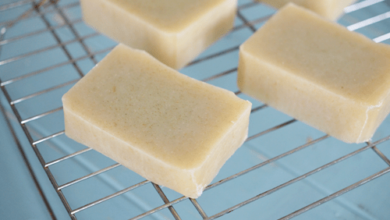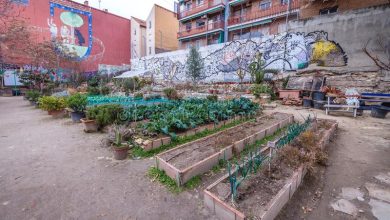What is nitrophoska and what is it used for?

So that the plants can grow strong and a little faster than they usually do, they can be given some type of fertilizer such as Nitrofoska. However, it is important to make good use of them, since if they were not done, the risk of overdose would be greater.
Taking this into account, we are going to explain what Nitrofoska is, one of the most used fertilizers, the different types that there are and how to use it so that the plants react as we expect; that is, growing up healthy.
What is nitrophoska?

Image – Wikimedia/ Dr. Eugen lehle
Nitrofoska is a range of complex fertilizers developed by Eurochem, a company that began as a multinational mining company and which also became a manufacturer of plant fertilizers. And it has not gone badly, since who does not know or has not heard of Nitrofoska? Whether you are an expert or not, it is likely that you have seen blue balls in the substrate of some of your plants, or that you have thrown them yourself.
But, what is it that differentiates this range of products from others? Well, actually, at present, not much as the agricultural industry is advancing by leaps and bounds. But in its day it was something innovative: each grain, that is, each pellet, contains several nutrients (some only nitrogen, phosphorus and potassium (NPK), others also micronutrients), instead of one or two that was what the Last century. This optimizes the application.
What nutrients does it include?
Nitrofoska, of whatever type, contains nitrogen, phosphorus and potassium. Some will also have other nutrients, all of them very important for plants. Let’s know what they are and what they use them for:
- Nitrogen (N): it is the most important nutrient, since it is responsible for growth.
- Phosphorus (P): stimulates the production of flowers, fruits and seeds, as well as roots.
- Potassium (K): it is necessary for plants to develop well.
- Magnesium: involved in photosynthesis.
- Sodium: maintains the ionic balance of cells.
- Micronutrients: calcium, iron, boron, sulfur and zinc. They all have different functions, such as regulating growth, or the formation of flowers and fruits.

Related article:The Nutrients Most Plants Need
Types of Nitrofoska
#gallery-1 {
margin: auto;
}
#gallery-1.gallery-item {
float: left;
margin-top: 10px;
text-align: center;
width: 50%;
}
#gallery-1 img {
border: 2px solid #cfcfcf;
}
#gallery-1.gallery-caption {
margin-left: 0;
}
/* see gallery_shortcode() in wp-includes/media.php */


There are many types, depending on their formulation:
- Nitrophoska 12 + 20 + 12
- Nitrofoska 13 + 9 + 16 (+ 4 + 17): in addition to containing NPK, it has magnesium and sodium.
- Nitrophoska triple 15
- Nitrofoska 22 + 8 + 10
- Special Nitrofoska, such as the special one for olive trees, which has NPK 20-5-10, and also magnesium, sulfur and micronutrients.
- Nitrofoska perfect 15 + 5 + 20 (+ 2 + 20 + 0.02 + 0.01): has NPK, magnesium, sodium, boron and zinc.
- Nitrofoska special 12 + 12 + 17 (+ 2 + 20 + 0.02 + 0.01): has NPK, magnesium, sodium, boron and zinc. You can get it here.
- Nitrofoska super 20 + 5 + 10 (+ 3 + 12.5 + 0.3): contains NPK, as well as magnesium, sodium, iron and boron.
- Foliar nitrophoska. Buy it here.
What is blue nitrophoska?
Nitrofoska Azul is a type of Nitrofoska Special with a balanced content of nutrients, both the main ones (nitrogen, phosphorus and potassium), as well as some of the secondary ones, such as calcium, iron or zinc, among others. It is soluble in water, but it also releases these nutrients little by little, which is very interesting for plants to have adequate growth.
The composition is as follows: NPK 12 + 12 + 17, and it also has magnesium, sodium, calcium, iron, boron and zinc. It is especially suitable for succulent plants (cacti, succulents) and for lawns. You want it? Buy it here.
What is Nitrofoska for citrus?
Citrus fruits tend to have nutrient deficiencies, which is why today you can fertilize them with Nitrofoska for citrus, a specific complex fertilizer to meet their needs. There are two formulations: one is Nitrofoska 14, whose composition is NPK 14 + 7 + 17 with 2% magnesium, which is more recommended for those who tend to have yellow leaves; and the other is Nitrofoska 21, whose composition is 21 + 8 + 11, more recommended for those who do not have problems.
How is the fertilizer applied?
We want our plants to be healthy and grow well, so it is highly recommended to fertilize them or fertilizers from time to time. But, as we said at the beginning, it is as important to pay as to pay well, and for this we have to read and follow the instructions for use that are on the packaging. If this is not done, we could add more than the appropriate amount, and as a consequence, the roots would suffer damage, perhaps irreversibly.
We must always bear in mind that more quantity does not mean greater efficiency. In fact, it happens that the more fertilizer we put in, the more risk of death the plant will have. Furthermore, we cannot expect a tree to grow, for example, 40 centimeters in a year when its natural growth rate is much slower.
With the fertilizer we can make it grow a little faster than it would be normal, but nothing exaggerated. That is, if it grows generally at a rate of 20 centimeters per year, we may be able to grow 25.
Therefore, to know how it is applied, you must read the label on the container. But generally it has to be thrown directly on the earth, mixing it a little with it and then watering it, or else diluting it first in water. In any case, the use of gloves is highly recommended.
What is the best time to fertilize the plants?

Plants are fertilized or fertilized when they are healthy, and when the right conditions are given for them to grow. In other words, they are only paid, or should be paid, during spring and summer, also in autumn if there is no frost or it is late. In winter you can add fertilizers or slow release fertilizers, but if during the rest of the year they have been well fed, it is not essential.
In addition, you must bear in mind that a diseased or recently transplanted plant must not be fertilized, as it is weak. It is better to wait a while, until you see new growth.
And you, do you usually use Nitrofoska?




